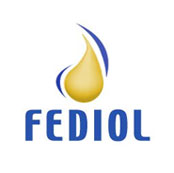2- and 3- MCPD Esters & GE
The vegetable oil and fat industry is committed to food safety and quality. Each vegetable oil and fat is subject to the highest standards of quality and safety controls, from the seeds, to the ingredient in food products or to the bottle. FEDIOL members are monitoring closely and taking actions on contaminants that are relevant to edible vegetable oils and fats. This includes 2- and 3-MCPD esters and glycidyl esters.
2- and 3- MCPD esters and glycidyl esters are substances that can arise in refined oils and fats during the refining process, as high temperatures are applied in order to achieve quality and safety specifications.
For years, FEDIOL members have proactively engaged in research on these substances, with a view to contribute to a better understanding on their occurrence in vegetable oils and fats, factors influencing their occurrence, development of analytical methods and mitigation techniques.
On glycidyl esters (GE), risk management discussions led to the setting of EU maximum levels (MLs) entering into force in 2018 (see Regulation (EU) 2018/290). Ahead, FEDIOL took a strong commitment in mid 2015 to reduce GE levels in all vegetable oils for food uses to a maximum 1mg/kg by September 2017.
For 3-MCPD esters, the European Food Safety Authority (EFSA) published its updated opinion in January 2018. EU risk management discussions took place and led to the setting of EU Maximum Levels under Regulation 2023/915.
Recent documents:
1. Developing and improving analytical methods for vegetable oils and fats
Huge efforts have been made in developing and evaluating analytical methodologies for 2- and 3-MCPD esters and glycidyl esters in vegetable oils and fats. Three validated methods of analysis (developed by SGS, DGF and Unilever) to test for 2- and 3-MCPD esters and glycidyl esters in vegetable oils and fats have been available since 2013 and became ISO standards. A fourth method (Zwagerman and Overman) is under ISO assessment.
A FEDIOL overview of available analytical methods so far which can be found here (updated March 2019). FEDIOL will continue monitoring analytical developments very closely and update its overview on a regular basis.
The Joint Research Center (JRC) developed methods for the analysis of 2- and3-MCPD (both in free and ester form) and glycidyl esters in more complex various food products. The document is available here. These methods have been validated in 2015.
2. Monitoring and collecting data
With the availability of validated analytical methods, levels of 2- and 3-MCPD esters and glycidyl esters have since then been identified with greater reliability in vegetable oils and fats.
FEDIOL regularly compiles occurrence data in vegetable oils and fats from its FEDIOL members. They are regularly shared with the European Food Safety Authority (EFSA).
3. Work by Authorities
In July 2014, the EU Commission has given mandate to EFSA to carry out an exposure and risk assessment on 2- and 3-MCPD, 2- and 3-MCPD esters and Glycidyl esters. See here.
A first EFSA opinion has been released on 3 May 2016. See here.
In November 2016, the Joint FAO/WHO Expert Committee on Food Additives (JECFA) also carried out a risk assessment on 3MCPD esters (see here).
Due to its updated EFSA guidance on benchmark dose modelling approach (BMDL), EFSA relooked into its opinion and published its update in January 2018.
For GE, EU maximum levels - for vegetable oils and fats and for infant and follow on formula - entered into force in 2018 (see Regulation (EU) 2018/290)
EU risk management discussions also took place for 3-MCPDE and led to the setting of EU Maximum Levels under Regulation 2023/915.
4. Improving the understanding on the intake of vegetable oils and fats
FEDIOL supported the initiation of a new model, to estimate the intake of vegetable oils and fats in the diet in a more comprehensive way. The model used EUROSTAT, EFSA, FAO data bases and FEDIOL specific expertise on EU vegetable oils and fats production and consumption.
The scientific publication and the model, co-authored by David Tennant and John Paul Gosling, have both been published in open access in the Food Additives and Contaminants Journal in August 2015. Both are available here.
5. Preventing and reducing levels
FEDIOL members have engaged actively in developing and implementing effective measures and technologies to prevent and reduce the occurrence of these substances.
In 2015, FEDIOL prepared a review of available mitigation techniques, which is available here.
To get a fuller picture on mitigation practices, the Codex Alimentarius intiated work on a Code of Practice for the reduction of 3-MCPDE and GE in refined oils and fats and food products made with refined oils and fats. As an observer to the Codex Alimentarius, FEDIOL provided input throughout the process. The Code of Practice was adopted in 2019 and can be found here.
update : 21/11/2019

